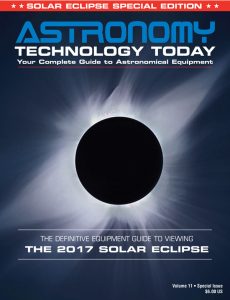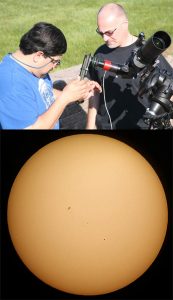 If you don’t already own a telescope, the Great American Solar Eclipse is an excellent reason to get started in astronomy.
If you don’t already own a telescope, the Great American Solar Eclipse is an excellent reason to get started in astronomy.
Over the last few decades there has been an explosion of innovative products from the amateur telescope industry, which means you can get a great telescope combination at a great price!
One of the unique aspects of today’s telescopes is their ability to be connected to your smart device. Using a planetarium/ telescope control app, you can pick what you want to see, press a button on your smart phone or tablet and your telescope does all the work – pointing the eyepiece exactly where it needs to be for you to grab glorious views of planets, stars and galaxies.
For solar observing, you need to remember – never look at the Sun through an unfiltered telescope! And you don’t have to, as you can view the Great Solar Eclipse through a telescope using “white light” solar filters.
 If you are just starting out, it’s a smart idea to buy a telescope that comes with everything you need – the telescope, mount, tripod, etc. While buying a telescope may seem confusing, it doesn’t have to be. A simple internet search will help you find a list of telescope manufacturers and astronomy retailers that not only sell astronomy products but also offer advice on which telescope/ telescope package best fits your specific needs. They also will be able to provide advice on the best solar filter to purchase with your telescope.
If you are just starting out, it’s a smart idea to buy a telescope that comes with everything you need – the telescope, mount, tripod, etc. While buying a telescope may seem confusing, it doesn’t have to be. A simple internet search will help you find a list of telescope manufacturers and astronomy retailers that not only sell astronomy products but also offer advice on which telescope/ telescope package best fits your specific needs. They also will be able to provide advice on the best solar filter to purchase with your telescope.
Or you can read our solar eclipse equipment guide – The Definitive Equipment Guide to the 2017 Solar Eclipse. In the guide, we provide an extensive list of retailers and manufacturers as a resource to help you find the perfect telescope setup.
Also, the 40-page publication provides an easy-to-consume introduction to the other technological options for viewing and imaging the Great Solar Eclipse. We cover the gamut of options available including building your own solar viewer, solar glasses, smart phones, DSLR cameras, using astronomy telescopes, solar telescopes, using binoculars, solar filters (including a DYI filter option), CCD astro cameras, astro video cameras, webcams and much more. You can view the guide on our website here – its free and there is no requirement to sign up to read the guide.
 Your local astronomy club, planetarium, science center or college are all great resources for you to seek advice. Here are several resources to help to find the one of these nearest you here.
Your local astronomy club, planetarium, science center or college are all great resources for you to seek advice. Here are several resources to help to find the one of these nearest you here.
You need the proper eyepieces to get the most out of your telescope. There a large variety of eyepieces – and you want to make sure you have those that are specifically designed to allow your telescope to deliver the optimum view of the object you are targeting. For the solar eclipse, make sure you have an eyepiece that lets you maximize your eclipse viewing.
The editors of Astronomy Magazine have teamed up with Celestron to create an easy-to-understand reference guide to help you decide the best telescope for you. They answer the most common questions about purchasing that first telescope, explain different telescopes types and provide an overview of what you can expect to see with your new telescope.
When choosing your telescope, make sure you buy one that has an available solar safe filter that can be placed in the front of the telescope. These allow you to safely view the solar eclipse and also protect your telescope from those hot sun rays!
If you don’t have a telescope with a tracking mount, be sure and invest in a solar finder, which provides a simple and easy way to keep your telescope aligned on the Sun – and doing so safely without looking directly at the Sun with your unprotected eyes! These handy accessories project an image of the sun onto a screen – once the Sun is centered on the screen, it is perfectly centered in your telescope, as well.
Finally, for added fun, you can buy an inexpensive adapter that allows you to attach your iPhone or Android smart phone to the telescope. Then you’ll be able to take images of the eclipse and even time lapse video. TeleVue’s FoneMate Smart Phone Adapter is one such device and is ruggedly built to hold any smart phone.
And the best thing is, once you’ve invested in a telescope setup, you can continue to use it to view the Sun, especially on days of high solar activity. Also, you can then start viewing the night sky with spectacular views of the moon, planets and many deep sky objects.



